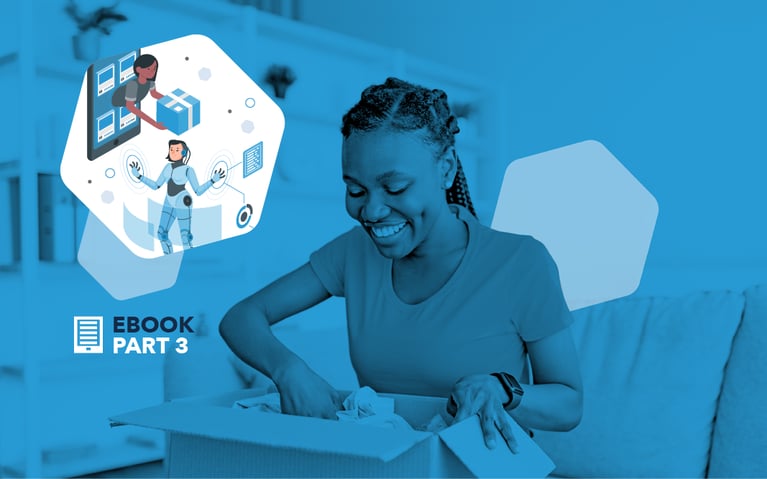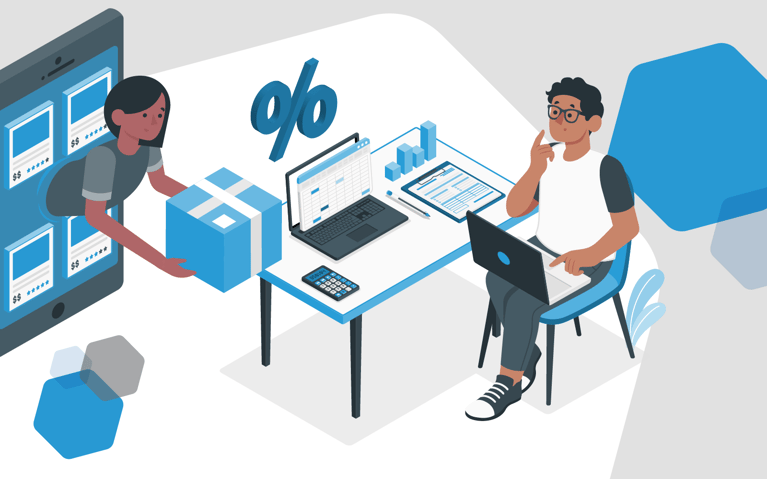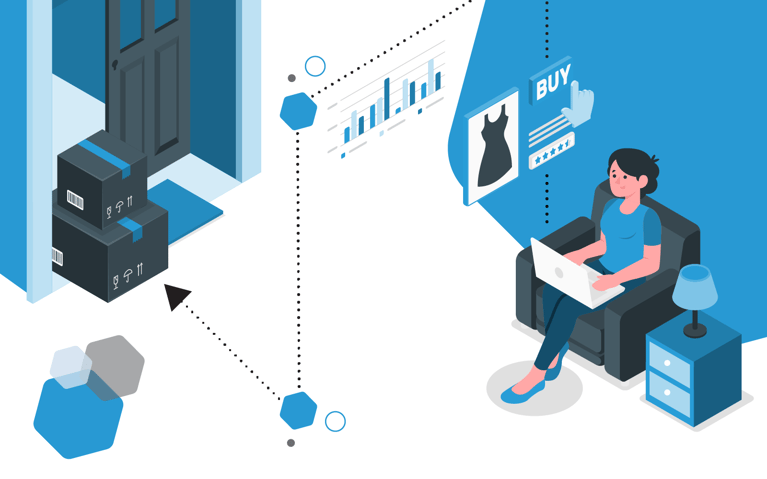You’ve done the hard work of attracting customers, engaging and converting them. However, the customer journey doesn’t stop there. In fact, let this sink in: 80% of customers say it’s important for a company’s post-purchase experience to be positive. This means they're still looking for engagement and interactions during the period between purchase and delivery. The question becomes, how do brands optimize the post-purchase experience to meet their needs?
The customer experience (CX) is not a new topic. Ecommerce retailers know that consistent, personalized, seamless omnichannel experiences are foundational to an exceptional experience. Customer support, communication and information are also imperative. This article will explore how to expand these elements into the post-purchase stages to create positive, memorable moments.
What is the post purchase-experience?
Let’s start with an example. You just visited a popular athletic shoe site, used the shoe finder and purchased a brand-new pair of trail running shoes. Eager to get started on your trail race training, you’re pleased when your phone pings: You’ve received an SMS letting you know your order was received and that you’d get shipping information as soon as the order was processed. You later see this information has been sent to your email as well: Both include an order link for on-demand updates.
It's not long before your item is processed and shipped, and now you can see real-time tracking and an estimated delivery date. You check in once and see that everything remains on time. The day your package is scheduled to arrive, you receive another text message letting you know and asking for any special instructions for the carrier.
When you get home from work, the box is sitting on your porch (you knew it would be – you got an SMS letting you know it was delivered!). The box has appealing graphics of mountains and an inspiring slogan – you can’t wait to open it. Unboxing doesn’t disappoint. Your new shoes are nestled in custom tissue and inside their very own travel bag. Within the bag are colorful sneakers ready for the trail, a thank you note and a QR code for a discount on your next purchase. You find yourself smiling.
What the post-purchase experience includes
The post-purchase experience includes any brand interactions, activities or messages a customer has after purchasing a product or service. This ranges from order confirmations to review requests and order processing to delivery. The period post-purchase is critical: It’s a time for building brand loyalty, trust and encouraging retention.
The importance of the post-purchase experience
An increasing number of statistics highlight the need for a seamless, positive and memorable post-purchase experience. Key studies and surveys show:
- 85% of online shoppers won’t reorder from an online retailer after a bad delivery experience
- 75% of consumers expect initial shipment notification, and 82% expect delivery confirmation
- 83% of purchasers expect updates about their order across stages
- 40% of the packages consumers received had no branding, even though 41% stated that unboxing experiences encouraged repeat purchases
- Customers are less likely to repurchase if they experience: Poor customer service (58%), mis-picks or packing errors (53%), wrong items (53%) or damaged items (51%)
Retail brands seeking to improve the post-purchase experience and optimize impact must leverage tools that prioritize visibility and information-sharing between operations, supply chain and customer success teams.
How to optimize the post-purchase experience
Optimizing the post-purchase experience begins with understanding each stage, from warehouse to doorstep – and even beyond. Then, approach your processes as a series of opportunities to delight your customers.
Order processing
When ordering details are sent to the OMS, processing begins. From the very start, you can optimize communication simply by messaging a customer with a push notification, email or SMS (text message) that the order has been received. Ensuring you have a modern OMS – or that your 3PL uses one – is the first step in optimizing the post-purchase experience. Plan to continue improving the customer experience through the rest of the order-processing workflow:
- Picking: Make sure your orders are consistently accurate.
- Packing: Balance packing in a way that increases brand awareness, keeps costs down and is most protective of the products.
- Shipping: Offer low-cost or free and fast shipping – it’s a trending customer expectation. Notify the customer that their order is ready for pickup and on the way, along with an estimated delivery date.
In general, your entire fulfillment process should be optimized, from how you handle inventory management to the packaging and carriers you use. Your fulfillment technology (e.g., your OMS/WMS) should support automations that enhance communication and provide real-time visibility. You should also have a robust returns management process in place. Working with an expert 3PL service gives you an operational edge and allows you to track, analyze and improve post-purchase stages.
Last-mile and delivery
During this stage, you rely on carrier relationships. Select carriers that can uphold your brand standards. You may want your customer to be able to provide delivery notes or change delivery location. Think about the little touches that will make your unique customers happy.
Letting the customer know an item is out for delivery and when it has been delivered should be a given. Some carriers, like UPS, will take pictures of their deliveries.
Unboxing
Today’s consumer has a fascination with unboxing. Thousands of videos feature people unboxing notable brands. More importantly, people watch them! Retailers can leverage the trend to:
- Tell a brand story
- Encourage social media shares
- Make it personal
- Add personal touches
- Enhance product presentation
- Offer freebies, thank yous and gifts
- Build brand loyalty
Unboxing is crucial for the post-purchase experience as it creates a memorable moment for customers. It enhances brand satisfaction, builds excitement and fosters a positive emotional connection. The carefully crafted unboxing experience not only adds value to the product but also strengthens brand loyalty, encouraging repeat purchases and positive word-of-mouth marketing.
Returns
As a percentage of sales, the total return rate for 2023 was 14.5%. Meaning how you manage returns is an integral part of the customer journey post-purchase. Consumers should be able to find a clear returns policy online. Moreover, it should be easy for them to make returns. The process must be streamlined and simple and provide options that make it convenient. For example, let them choose carrier pick up or drop a return at a postal store. Notify the customer throughout the process and refund swiftly upon receipt. Providing options to exchange items or get store credit is also helpful.
Other ways to optimize post-purchase experiences
Keep post-purchase best practices in mind. You can:
- Offer multiple shipping options
- Communicate any delays and be open to offering incentives if packages are delayed
- Build loyalty through communication, thank yous, discounts, sending recommendations (if the customer is interested) and encouraging reviews
- Offer customer support through multiple channels: Live chat, social media, email and phone
- Deliver on-time
- Ensure the customer receives an itemize receipt
KPIs to track
When you’ve done a stellar job with the post-purchase experience, you’ll see a boost to several key metrics:
Traffic
When traffic builds through direct, email or referral, it’s likely due to repeat customers. When this starts to happen, use it as an opportunity to discover what works and fine-tune your strategies.
LTV (Lifetime value)
Your customer LTV is the culmination of a customer’s total purchases. As your post-purchase experience gets better, you’ll see a bump in LTVs. Customers want more of what you’ve given them.
Conversion rate
The first purchase isn’t always the easiest. Once you’ve proven you’re a great brand, it’s much easier for customers to complete the checkout process. This means more sales and a higher conversion rate.
Increased reviews and ratings
When people are delighted, they’re happy to tell the world. As you create memorable moments, customer may be more inclined to tell others about their experience. That, in turn, can bolster the number of product reviews and the average rating.
Create an exceptional post-purchase customer experience today
The post-purchase customer experience is vital for building long-term relationships and brand loyalty. It goes beyond the transaction, focusing on customer satisfaction, engagement and support after a purchase. A positive post-purchase experience enhances customer retention, encourages brand advocacy and contributes to a strong, positive brand image. Investing in post-purchase interactions is key to creating loyal customers and fostering a thriving business. For an exceptional fulfillment experience, contact the team at Cart.com today.
Subscribe to our emails for the latest industry insights!
By entering your email, you agree to receive marketing emails from Cart.com






